Pacific Surfliner
|
| ||||||||||||||||||||||||||||||||||||||||||||||||||||||||||||||||||||||||||||||||||||||||||||||||||||||||||||||||||||||||||||||||||||||||||||||||||||||||||||||||||||||||||||||||||||||||||||||||||||||||||||||||||||||||||||||||||||||||||||||||||||||||||||||||||||||||||||||||||||||||||||||||||||||||||||||||||||||||||||||||||||||||||||||||||||||||||||||||||||||||||||||||||||||||||||||||||||||||||||||||||||||||||||||||||||||||||||||||||||||||||||||||||||||||||||||||||||||||||||
 A Pacific Surfliner enters San Clemente, California in 2008 | ||||||||||||||||||||||||||||||||||||||||||||||||||||||||||||||||||||||||||||||||||||||||||||||||||||||||||||||||||||||||||||||||||||||||||||||||||||||||||||||||||||||||||||||||||||||||||||||||||||||||||||||||||||||||||||||||||||||||||||||||||||||||||||||||||||||||||||||||||||||||||||||||||||||||||||||||||||||||||||||||||||||||||||||||||||||||||||||||||||||||||||||||||||||||||||||||||||||||||||||||||||||||||||||||||||||||||||||||||||||||||||||||||||||||||||||||||||||||||||
| Overview | ||||||||||||||||||||||||||||||||||||||||||||||||||||||||||||||||||||||||||||||||||||||||||||||||||||||||||||||||||||||||||||||||||||||||||||||||||||||||||||||||||||||||||||||||||||||||||||||||||||||||||||||||||||||||||||||||||||||||||||||||||||||||||||||||||||||||||||||||||||||||||||||||||||||||||||||||||||||||||||||||||||||||||||||||||||||||||||||||||||||||||||||||||||||||||||||||||||||||||||||||||||||||||||||||||||||||||||||||||||||||||||||||||||||||||||||||||||||||||||
|---|---|---|---|---|---|---|---|---|---|---|---|---|---|---|---|---|---|---|---|---|---|---|---|---|---|---|---|---|---|---|---|---|---|---|---|---|---|---|---|---|---|---|---|---|---|---|---|---|---|---|---|---|---|---|---|---|---|---|---|---|---|---|---|---|---|---|---|---|---|---|---|---|---|---|---|---|---|---|---|---|---|---|---|---|---|---|---|---|---|---|---|---|---|---|---|---|---|---|---|---|---|---|---|---|---|---|---|---|---|---|---|---|---|---|---|---|---|---|---|---|---|---|---|---|---|---|---|---|---|---|---|---|---|---|---|---|---|---|---|---|---|---|---|---|---|---|---|---|---|---|---|---|---|---|---|---|---|---|---|---|---|---|---|---|---|---|---|---|---|---|---|---|---|---|---|---|---|---|---|---|---|---|---|---|---|---|---|---|---|---|---|---|---|---|---|---|---|---|---|---|---|---|---|---|---|---|---|---|---|---|---|---|---|---|---|---|---|---|---|---|---|---|---|---|---|---|---|---|---|---|---|---|---|---|---|---|---|---|---|---|---|---|---|---|---|---|---|---|---|---|---|---|---|---|---|---|---|---|---|---|---|---|---|---|---|---|---|---|---|---|---|---|---|---|---|---|---|---|---|---|---|---|---|---|---|---|---|---|---|---|---|---|---|---|---|---|---|---|---|---|---|---|---|---|---|---|---|---|---|---|---|---|---|---|---|---|---|---|---|---|---|---|---|---|---|---|---|---|---|---|---|---|---|---|---|---|---|---|---|---|---|---|---|---|---|---|---|---|---|---|---|---|---|---|---|---|---|---|---|---|---|---|---|---|---|---|---|---|---|---|---|---|---|---|---|---|---|---|---|---|---|---|---|---|---|---|---|---|---|---|---|---|---|---|---|---|---|---|---|---|---|---|---|---|---|---|---|---|---|---|---|---|---|---|---|---|---|---|---|---|---|---|---|---|---|---|---|---|---|---|---|---|---|---|---|---|---|---|---|---|---|---|---|---|---|---|---|---|---|---|---|---|---|---|---|---|---|---|---|---|---|---|---|---|---|---|---|---|---|---|---|---|---|---|---|---|
| Service type | Inter-city rail | |||||||||||||||||||||||||||||||||||||||||||||||||||||||||||||||||||||||||||||||||||||||||||||||||||||||||||||||||||||||||||||||||||||||||||||||||||||||||||||||||||||||||||||||||||||||||||||||||||||||||||||||||||||||||||||||||||||||||||||||||||||||||||||||||||||||||||||||||||||||||||||||||||||||||||||||||||||||||||||||||||||||||||||||||||||||||||||||||||||||||||||||||||||||||||||||||||||||||||||||||||||||||||||||||||||||||||||||||||||||||||||||||||||||||||||||||||||||||||
| Locale | Southern California | |||||||||||||||||||||||||||||||||||||||||||||||||||||||||||||||||||||||||||||||||||||||||||||||||||||||||||||||||||||||||||||||||||||||||||||||||||||||||||||||||||||||||||||||||||||||||||||||||||||||||||||||||||||||||||||||||||||||||||||||||||||||||||||||||||||||||||||||||||||||||||||||||||||||||||||||||||||||||||||||||||||||||||||||||||||||||||||||||||||||||||||||||||||||||||||||||||||||||||||||||||||||||||||||||||||||||||||||||||||||||||||||||||||||||||||||||||||||||||
| Predecessor | San Diegan | |||||||||||||||||||||||||||||||||||||||||||||||||||||||||||||||||||||||||||||||||||||||||||||||||||||||||||||||||||||||||||||||||||||||||||||||||||||||||||||||||||||||||||||||||||||||||||||||||||||||||||||||||||||||||||||||||||||||||||||||||||||||||||||||||||||||||||||||||||||||||||||||||||||||||||||||||||||||||||||||||||||||||||||||||||||||||||||||||||||||||||||||||||||||||||||||||||||||||||||||||||||||||||||||||||||||||||||||||||||||||||||||||||||||||||||||||||||||||||
| First service | June 1, 2000 | |||||||||||||||||||||||||||||||||||||||||||||||||||||||||||||||||||||||||||||||||||||||||||||||||||||||||||||||||||||||||||||||||||||||||||||||||||||||||||||||||||||||||||||||||||||||||||||||||||||||||||||||||||||||||||||||||||||||||||||||||||||||||||||||||||||||||||||||||||||||||||||||||||||||||||||||||||||||||||||||||||||||||||||||||||||||||||||||||||||||||||||||||||||||||||||||||||||||||||||||||||||||||||||||||||||||||||||||||||||||||||||||||||||||||||||||||||||||||||
| Current operator(s) | Los Angeles – San Diego – San Luis Obispo Rail Corridor Agency, in partnership with Amtrak and Caltrans | |||||||||||||||||||||||||||||||||||||||||||||||||||||||||||||||||||||||||||||||||||||||||||||||||||||||||||||||||||||||||||||||||||||||||||||||||||||||||||||||||||||||||||||||||||||||||||||||||||||||||||||||||||||||||||||||||||||||||||||||||||||||||||||||||||||||||||||||||||||||||||||||||||||||||||||||||||||||||||||||||||||||||||||||||||||||||||||||||||||||||||||||||||||||||||||||||||||||||||||||||||||||||||||||||||||||||||||||||||||||||||||||||||||||||||||||||||||||||||
| Ridership | 2,924,117 (FY16)[1] | |||||||||||||||||||||||||||||||||||||||||||||||||||||||||||||||||||||||||||||||||||||||||||||||||||||||||||||||||||||||||||||||||||||||||||||||||||||||||||||||||||||||||||||||||||||||||||||||||||||||||||||||||||||||||||||||||||||||||||||||||||||||||||||||||||||||||||||||||||||||||||||||||||||||||||||||||||||||||||||||||||||||||||||||||||||||||||||||||||||||||||||||||||||||||||||||||||||||||||||||||||||||||||||||||||||||||||||||||||||||||||||||||||||||||||||||||||||||||||
| Website | Pacific Surfliner | |||||||||||||||||||||||||||||||||||||||||||||||||||||||||||||||||||||||||||||||||||||||||||||||||||||||||||||||||||||||||||||||||||||||||||||||||||||||||||||||||||||||||||||||||||||||||||||||||||||||||||||||||||||||||||||||||||||||||||||||||||||||||||||||||||||||||||||||||||||||||||||||||||||||||||||||||||||||||||||||||||||||||||||||||||||||||||||||||||||||||||||||||||||||||||||||||||||||||||||||||||||||||||||||||||||||||||||||||||||||||||||||||||||||||||||||||||||||||||
| Route | ||||||||||||||||||||||||||||||||||||||||||||||||||||||||||||||||||||||||||||||||||||||||||||||||||||||||||||||||||||||||||||||||||||||||||||||||||||||||||||||||||||||||||||||||||||||||||||||||||||||||||||||||||||||||||||||||||||||||||||||||||||||||||||||||||||||||||||||||||||||||||||||||||||||||||||||||||||||||||||||||||||||||||||||||||||||||||||||||||||||||||||||||||||||||||||||||||||||||||||||||||||||||||||||||||||||||||||||||||||||||||||||||||||||||||||||||||||||||||||
| Start | San Luis Obispo, California | |||||||||||||||||||||||||||||||||||||||||||||||||||||||||||||||||||||||||||||||||||||||||||||||||||||||||||||||||||||||||||||||||||||||||||||||||||||||||||||||||||||||||||||||||||||||||||||||||||||||||||||||||||||||||||||||||||||||||||||||||||||||||||||||||||||||||||||||||||||||||||||||||||||||||||||||||||||||||||||||||||||||||||||||||||||||||||||||||||||||||||||||||||||||||||||||||||||||||||||||||||||||||||||||||||||||||||||||||||||||||||||||||||||||||||||||||||||||||||
| Stops | 27 | |||||||||||||||||||||||||||||||||||||||||||||||||||||||||||||||||||||||||||||||||||||||||||||||||||||||||||||||||||||||||||||||||||||||||||||||||||||||||||||||||||||||||||||||||||||||||||||||||||||||||||||||||||||||||||||||||||||||||||||||||||||||||||||||||||||||||||||||||||||||||||||||||||||||||||||||||||||||||||||||||||||||||||||||||||||||||||||||||||||||||||||||||||||||||||||||||||||||||||||||||||||||||||||||||||||||||||||||||||||||||||||||||||||||||||||||||||||||||||
| End | San Diego, California | |||||||||||||||||||||||||||||||||||||||||||||||||||||||||||||||||||||||||||||||||||||||||||||||||||||||||||||||||||||||||||||||||||||||||||||||||||||||||||||||||||||||||||||||||||||||||||||||||||||||||||||||||||||||||||||||||||||||||||||||||||||||||||||||||||||||||||||||||||||||||||||||||||||||||||||||||||||||||||||||||||||||||||||||||||||||||||||||||||||||||||||||||||||||||||||||||||||||||||||||||||||||||||||||||||||||||||||||||||||||||||||||||||||||||||||||||||||||||||
| Distance travelled | 350 miles (563 km) | |||||||||||||||||||||||||||||||||||||||||||||||||||||||||||||||||||||||||||||||||||||||||||||||||||||||||||||||||||||||||||||||||||||||||||||||||||||||||||||||||||||||||||||||||||||||||||||||||||||||||||||||||||||||||||||||||||||||||||||||||||||||||||||||||||||||||||||||||||||||||||||||||||||||||||||||||||||||||||||||||||||||||||||||||||||||||||||||||||||||||||||||||||||||||||||||||||||||||||||||||||||||||||||||||||||||||||||||||||||||||||||||||||||||||||||||||||||||||||
| Average journey time | 8 hours 15 minutes | |||||||||||||||||||||||||||||||||||||||||||||||||||||||||||||||||||||||||||||||||||||||||||||||||||||||||||||||||||||||||||||||||||||||||||||||||||||||||||||||||||||||||||||||||||||||||||||||||||||||||||||||||||||||||||||||||||||||||||||||||||||||||||||||||||||||||||||||||||||||||||||||||||||||||||||||||||||||||||||||||||||||||||||||||||||||||||||||||||||||||||||||||||||||||||||||||||||||||||||||||||||||||||||||||||||||||||||||||||||||||||||||||||||||||||||||||||||||||||
| Train number(s) |
Southbound: 562, 564, 566/1566, 768, 572, 774, 580, 782, 584, 1588, 590, 792, 796 Northbound: 761/1761, 763, 759, 565, 567/1567, 769, 573, 777, 579, 583, 785, 591, 595[2] | |||||||||||||||||||||||||||||||||||||||||||||||||||||||||||||||||||||||||||||||||||||||||||||||||||||||||||||||||||||||||||||||||||||||||||||||||||||||||||||||||||||||||||||||||||||||||||||||||||||||||||||||||||||||||||||||||||||||||||||||||||||||||||||||||||||||||||||||||||||||||||||||||||||||||||||||||||||||||||||||||||||||||||||||||||||||||||||||||||||||||||||||||||||||||||||||||||||||||||||||||||||||||||||||||||||||||||||||||||||||||||||||||||||||||||||||||||||||||||
| On-board services | ||||||||||||||||||||||||||||||||||||||||||||||||||||||||||||||||||||||||||||||||||||||||||||||||||||||||||||||||||||||||||||||||||||||||||||||||||||||||||||||||||||||||||||||||||||||||||||||||||||||||||||||||||||||||||||||||||||||||||||||||||||||||||||||||||||||||||||||||||||||||||||||||||||||||||||||||||||||||||||||||||||||||||||||||||||||||||||||||||||||||||||||||||||||||||||||||||||||||||||||||||||||||||||||||||||||||||||||||||||||||||||||||||||||||||||||||||||||||||||
| Class(es) | Coach Class (unreserved); Business Class (reserved) | |||||||||||||||||||||||||||||||||||||||||||||||||||||||||||||||||||||||||||||||||||||||||||||||||||||||||||||||||||||||||||||||||||||||||||||||||||||||||||||||||||||||||||||||||||||||||||||||||||||||||||||||||||||||||||||||||||||||||||||||||||||||||||||||||||||||||||||||||||||||||||||||||||||||||||||||||||||||||||||||||||||||||||||||||||||||||||||||||||||||||||||||||||||||||||||||||||||||||||||||||||||||||||||||||||||||||||||||||||||||||||||||||||||||||||||||||||||||||||
| Catering facilities | Seaview Café Car | |||||||||||||||||||||||||||||||||||||||||||||||||||||||||||||||||||||||||||||||||||||||||||||||||||||||||||||||||||||||||||||||||||||||||||||||||||||||||||||||||||||||||||||||||||||||||||||||||||||||||||||||||||||||||||||||||||||||||||||||||||||||||||||||||||||||||||||||||||||||||||||||||||||||||||||||||||||||||||||||||||||||||||||||||||||||||||||||||||||||||||||||||||||||||||||||||||||||||||||||||||||||||||||||||||||||||||||||||||||||||||||||||||||||||||||||||||||||||||
| Technical | ||||||||||||||||||||||||||||||||||||||||||||||||||||||||||||||||||||||||||||||||||||||||||||||||||||||||||||||||||||||||||||||||||||||||||||||||||||||||||||||||||||||||||||||||||||||||||||||||||||||||||||||||||||||||||||||||||||||||||||||||||||||||||||||||||||||||||||||||||||||||||||||||||||||||||||||||||||||||||||||||||||||||||||||||||||||||||||||||||||||||||||||||||||||||||||||||||||||||||||||||||||||||||||||||||||||||||||||||||||||||||||||||||||||||||||||||||||||||||||
| Rolling stock |
EMD F59PHI and GE P42DC locomotives Surfliner and Superliner coaches | |||||||||||||||||||||||||||||||||||||||||||||||||||||||||||||||||||||||||||||||||||||||||||||||||||||||||||||||||||||||||||||||||||||||||||||||||||||||||||||||||||||||||||||||||||||||||||||||||||||||||||||||||||||||||||||||||||||||||||||||||||||||||||||||||||||||||||||||||||||||||||||||||||||||||||||||||||||||||||||||||||||||||||||||||||||||||||||||||||||||||||||||||||||||||||||||||||||||||||||||||||||||||||||||||||||||||||||||||||||||||||||||||||||||||||||||||||||||||||
| Track gauge | 1,435 mm (4 ft 8 1⁄2 in) | |||||||||||||||||||||||||||||||||||||||||||||||||||||||||||||||||||||||||||||||||||||||||||||||||||||||||||||||||||||||||||||||||||||||||||||||||||||||||||||||||||||||||||||||||||||||||||||||||||||||||||||||||||||||||||||||||||||||||||||||||||||||||||||||||||||||||||||||||||||||||||||||||||||||||||||||||||||||||||||||||||||||||||||||||||||||||||||||||||||||||||||||||||||||||||||||||||||||||||||||||||||||||||||||||||||||||||||||||||||||||||||||||||||||||||||||||||||||||||
| Operating speed |
90 mph (145 km/h) (top) 41.2 mph (66.3 km/h) (average) | |||||||||||||||||||||||||||||||||||||||||||||||||||||||||||||||||||||||||||||||||||||||||||||||||||||||||||||||||||||||||||||||||||||||||||||||||||||||||||||||||||||||||||||||||||||||||||||||||||||||||||||||||||||||||||||||||||||||||||||||||||||||||||||||||||||||||||||||||||||||||||||||||||||||||||||||||||||||||||||||||||||||||||||||||||||||||||||||||||||||||||||||||||||||||||||||||||||||||||||||||||||||||||||||||||||||||||||||||||||||||||||||||||||||||||||||||||||||||||
| ||||||||||||||||||||||||||||||||||||||||||||||||||||||||||||||||||||||||||||||||||||||||||||||||||||||||||||||||||||||||||||||||||||||||||||||||||||||||||||||||||||||||||||||||||||||||||||||||||||||||||||||||||||||||||||||||||||||||||||||||||||||||||||||||||||||||||||||||||||||||||||||||||||||||||||||||||||||||||||||||||||||||||||||||||||||||||||||||||||||||||||||||||||||||||||||||||||||||||||||||||||||||||||||||||||||||||||||||||||||||||||||||||||||||||||||||||||||||||||
The Pacific Surfliner is a 350-mile (560 km) passenger train service operated by Amtrak, serving the communities on the coast of Southern California between San Diego and San Luis Obispo.
The service carried 2,924,117 passengers during fiscal year 2016, a 3.4% increase from FY2015. Total revenue during FY2016 was $73,020,267, an increase of 3.6% over FY2015.[1] The Pacific Surfliner was Amtrak's third-busiest service (exceeded in ridership only by the Northeast Regional and Acela Express), and the busiest outside the Northeast Corridor.[1]
The route is the successor of the San Diegan, which had been one of the premier trains of the Santa Fe Railway until Amtrak took over operations in 1971. Initially there were three daily trips, but in 1976 the schedule was expanded. In 1988 the service was extended to Santa Barbara, followed in 1995 with one trip a day going all the way to San Luis Obispo. As the name "San Diegan" no longer reflected the extent of the route, it was renamed the Pacific Surfliner in 2000.[3] The route is named after the Atchison, Topeka and Santa Fe Railway's Surf Line.
Like all regional trains in California, the Pacific Surfliner is operated by a joint powers authority. The Los Angeles – San Diego – San Luis Obispo (LOSSAN) Rail Corridor Agency is governed by a board that includes eleven elected representatives from the counties the train travels through. LOSSAN contracts with the Orange County Transportation Authority to provide day-to-day management of the service and with contracts with Amtrak to operate the service and maintain the rolling stock (locomotives and passenger cars). The California Department of Transportation (Caltrans) provides the funding to operate the service and also owns some of the rolling stock.[4]
Operations
The 350-mile (563 km) San Luis Obispo-San Diego trip takes approximately 8½ hours with an average speed of 41.2 miles per hour (66 km/h); maximum track speed is 79 to 90 miles per hour (127 to 145 km/h). Much of the Pacific Surfliner's scenic route follows the Pacific coast, with the tracks being less than 100 feet from the ocean in some locations. However, trains travel inland through expansive farmlands in Ventura County and industrial backlots in the Los Angeles Basin, San Fernando Valley, and parts of Orange County. The Pacific Surfliner operates 24 daily trains between LA and San Diego.
On the northernmost part, there are two trains per day in each direction. Thruway Motorcoach connections are available between Santa Barbara, California and Paso Robles during hours when that part of the Coast Line track is in use by freight trains.
The 500 series trains go from LA to San Diego and two of the 700 series trains go onto the northernmost part of the route, with all 5 of the 700 series trains serving the entire route up to Goleta. For trains 761, 566, 567, and 790, they operate slightly different schedules on weekends and they are recognized by having a 1 in front of their number (i.e. 1761). As of the April 3, 2017 schedule, Amtrak also created slightly different schedules for trains 768, 572, 583, and 591 for the weekend but didn't add a 1 to the front.
Because the San Luis Obispo and Goleta stations are not equipped to turn equipment, and the San Diego station requires a time consuming non-revenue movement into a wye located about 16 miles to the north in Miramar, trains are operated in push-pull mode. The locomotive is at the rear of the train, pushing the train from Goleta, San Luis Obispo or San Diego to Los Angeles. At Los Angeles, the train reverses at the station, and the locomotive pulls the train to San Diego or Goleta/San Luis Obispo, respectively. A project is currently being prepared for run-through tracks at Union Station in Los Angeles.[5] As of 2007, the route recovers 63% of its operating expenses through ticket sales.[6]
Stops at Orange and Laguna Niguel/Mission Viejo were added in 2007, but later dropped. On October 7, 2013, stops were added at Coaster stations at Carlsbad Village, Carlsbad Poinsettia, Encinitas and Sorrento Valley.[7] The Carlsbad Poinsettia and Encinitas stops were dropped on October 9, 2017 due to low ridership.[8]
Amtrak's Thruway Motorcoach bus service connects passengers from Santa Barbara and San Luis Obispo to Solvang, Buellton, Lompoc, Grover Beach, Atascadero and Paso Robles.[2]
LOSSAN
Local agencies along with the host railroads formed the Los Angeles–San Diego-San Luis Obispo Rail Corridor Agency (LOSSAN) in 1989.[9] The Pacific Surfliner is operated by Amtrak under the Amtrak California brand with funding provided by the California Department of Transportation (Caltrans). Serious discussions were held in 2009 regarding the local agencies administering the service rather than Caltrans.[10] California Senate Bill No. 1225, passed in 2014, allowed LOSSAN to amend the joint powers agreement and become the sponsor of state-supported intercity passenger rail service in the corridor.[11] In mid-2015, LOSSAN assumed oversight for the Surfliner.[12] They are also working with Caltrans to assess rail operations from Los Angeles to San Diego to develop better connections, close gaps in the schedule, and optimize the assets of the railroad.[13]
Route
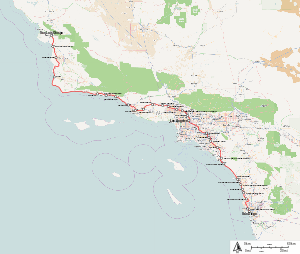
The Pacific Surfliner runs on track owned by several private railroads and public agencies:
- Union Pacific Railroad: San Luis Obispo – Moorpark
- Southern California Regional Rail Authority: Moorpark – Los Angeles
- BNSF Railway: Los Angeles – Fullerton
- Southern California Regional Rail Authority: Fullerton – Orange County/San Diego County line
- North County Transit District: Orange County/San Diego County line – San Diego
Stations
- San Luis Obispo
- Grover Beach
- Guadalupe
- Lompoc–Surf
- Goleta
- Santa Barbara
- Carpinteria
- Ventura
- Oxnard
- Camarillo (Limited service)
- Moorpark (Limited service)
- Simi Valley
- Chatsworth
- Van Nuys
- Hollywood Burbank Airport
- Glendale
- Los Angeles Union Station
- Fullerton
- Anaheim
- Santa Ana
- Irvine
- San Juan Capistrano
- San Clemente Pier (Limited service)
- Oceanside
- Carlsbad Village (Limited service)
- Solana Beach
- San Diego–Sorrento Valley (Limited service)
- San Diego–Old Town
- San Diego Santa Fe Depot
Rolling stock
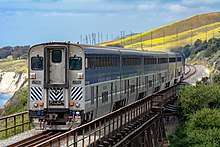
The Pacific Surfliner uses push-pull trainsets with a diesel locomotive at one end and a cab car at the other. Eight of the nine trainsets used for regular service use a fleet of 49 bilevel Surfliner coaches (39 owned by Amtrak and 10 by Caltrans), plus nine leased Amtrak Superliner long-distance coaches modified for push-pull operation. A typical six-car set has a business class car; three coach cars; a coach/café car with food sales on the lower level; and a coach/baggage/cab car equipped with coach seating, a checked baggage space on the lower level, and engineer's operating cab.[14] The ninth trainset consists of leased Amtrak equipment: Horizon or Amfleet passenger cars plus a Non-Powered Control Unit.[14] All Pacific Surfliner trains are pulled by a dedicated fleet of 15 Amtrak-owned EMD F59PHI locomotives, with Amtrak-owned GE P42DC locomotives also used.[14] The Surfliner cars and F59PHI locomotives are painted in a blue and silver livery that is unique to the Pacific Surfliner.[15][16]
From 2018 to 2020, the F59PHI locomotives will be replaced with 16 new Siemens Charger locomotives - part of a 22-unit order by Caltrans.[17][18] The F59PHI locomotives were sold to Metra in 2018; Amtrak P42DC locomotives will be used on the Pacific Surfliner until the Chargers enter service.[14][19] The Surfliner cars will be supplemented and partially replaced by new Siemens single-level cars beginning in 2020.[14] In 2018, to provide additional capacity before the new cars arrive, LOSSAN began negotiating with the Great Lakes Central Railroad to lease bilevel railcars previously refurbished for a never-opened commuter railroad in Michigan.[14]
Additional Amtrak-owned cars are added (up to 12-car consists) during periods of high demand, including the San Diego Comic-Con, events at the Del Mar racetrack, and after the 2018 Southern California mudflows closed Highway 101.[20][21] Amtrak Great Dome car Ocean View is occasionally used as an additional business class car.[22]
.jpg) A typical bilevel consist in 2013
A typical bilevel consist in 2013 A typical single-level consist in 2010
A typical single-level consist in 2010- Lower-level seating on a "Pacific Business Class" car in 2012
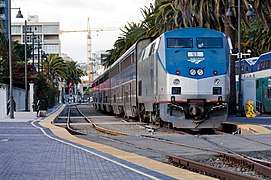 A Pacific Surfliner train hauled by a P42DC locomotive in 2012
A Pacific Surfliner train hauled by a P42DC locomotive in 2012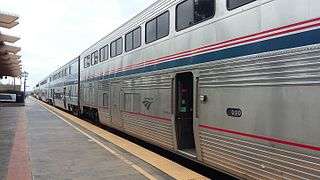 A Superliner car used in 2016
A Superliner car used in 2016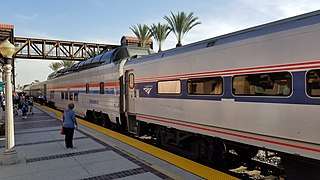 Ocean View on the Pacific Surfliner in 2016
Ocean View on the Pacific Surfliner in 2016
References
- 1 2 3 "Amtrak FY16 Ridership and Revenue Fact Sheet" (PDF). Amtrak. April 17, 2017. Retrieved February 21, 2018.
- 1 2 "Pacific Surfliner Schedule" (PDF). Amtrak. October 9, 2017. Retrieved February 21, 2018.
- ↑ Gabbard, Dana (September 24, 2012). "History of the Surfliner, LOSSAN and a Look at Pending Legislation". StreetsBlog LA. OpenPlans. Retrieved April 11, 2014.
- ↑ "Amtrak California". Wikipedia. December 11, 2017.
- ↑ "SCRIP - The Southern California Regional Interconnection Project". Los Angeles County Metropolitan Transportation Authority. Archived from the original on April 17, 2016. Retrieved May 8, 2016.
- ↑ Lam Nguyen (September 23, 2008). "FY 2007-08 Rail Operations Report" (PDF). State of California Department of Transportation.
- ↑ "Amtrak Pacific Surfliner Adds Four New stops" (Press release). Amtrak. September 18, 2013.
- ↑ Diehl, Phil (September 21, 2017). "Amtrak to discontinue two stops, add one". San Diego Union Tribune. Retrieved September 30, 2017.
- ↑ "LOSSAN Corridorwide Strategic Implementation Plan, Final Report (April 2012)" (PDF). San Luis Obispo Council of Governments. Retrieved April 24, 2018.
- ↑ "LOSSAN Board discusses JPA and the Future Governance of Passenger Rail in Southern California". Rail Passenger Association of California & Nevada. Retrieved December 6, 2009.
- ↑ "Senate Bill No. 1225" California Secretary of State (September 29, 2012)
- ↑ Sheehan, Tim (June 26, 2015). "Valley agency takes control of Amtrak San Joaquin trains". Fresno Bee. Retrieved February 11, 2016.
- ↑ Weikel, Dan (January 27, 2015) "Little-known agency keeps commuter rail network on track" Los Angeles Times
- 1 2 3 4 5 6 "Chapter 9: Equipment". LOSSAN Rail Corridor Agency Business Plan: FY 2018-19 to FY 2019-20 (PDF). Los Angeles – San Diego – San Luis Obispo Rail Corridor Agency. April 2018. pp. 41–47.
- ↑ "Official Paint Scheme and Logo Branding Guide" (PDF). Amtrak. August 17, 2018. Archived (PDF) from the original on September 18, 2018.
- ↑ Solomon, Brian (2004). Amtrak. Saint Paul, Minnesota: MBI. pp. 114, 138. ISBN 978-0-7603-1765-5.
- ↑ "Cleaner Locomotive Fleet Powers Up: 22 New Units Ordered for State-Supported Amtrak Corridors" (PDF). The Mile Marker. Caltrans. December 2016. pp. 31–32.
- ↑ Young, Allen (November 6, 2015). "Siemens Sacramento nabs $240M multistate contract". Sacramento Business Journal.
- ↑ "Metra moves to buy newer engines" (Press release). Metra. February 21, 2018.
- ↑ "EXTRA PACIFIC SURFLINER SERVICE AND CAPACITY ADDED FOR COMIC-CON". Pacific Surfliner Blog. Amtrak. July 11, 2018.
- ↑ "Amtrak boosts Pacific Surfliner capacity in response to mudslides". Progressive Railroading. January 16, 2018.
- ↑ "PANORAMIC VIEWS OF THE CALIFORNIA COAST FROM THE GREAT DOME". Pacific Surfliner Blog. Amtrak. July 14, 2017.
External links
| Wikimedia Commons has media related to Pacific Surfliner. |
Route map: